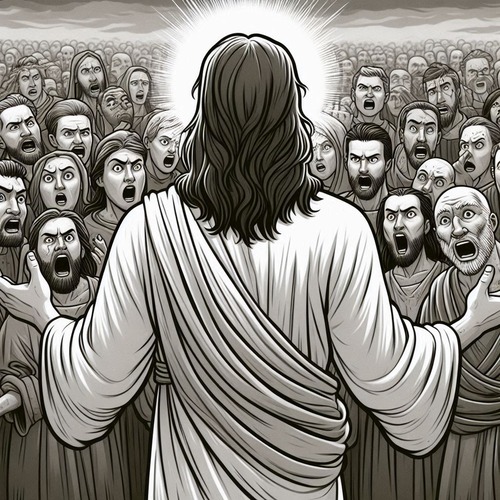The Passover Connection: Why Jesus’ Legs Weren’t Broken
Spare a thought for the breathtaking precision of God’s plan of salvation. Centuries before the Roman soldiers approached the cross of Christ with iron mallets in hand, the Creator had already decreed how this moment would unfold. The death of the Son of God was no improvised rescue mission—it was meticulously choreographed down to the smallest detail.
The Lamb of God had to die precisely at Passover, had to be without blemish, and critically, His bones could not be broken. As Roman soldiers shattered the legs of the criminals flanking Jesus but passed Him by, they unwittingly fulfilled prophecies written hundreds of years before their birth. This seemingly minor detail—the preservation of Christ’s legs on the cross—reveals a divine signature across history that transforms how we understand the crucifixion.
ROMAN CRUCIFIXION AND JEWISH CUSTOM: A COLLISION OF WORLDS
Roman crucifixion was designed to be excruciating, even humiliating. Victims typically died slowly from asphyxiation as they struggled to push themselves up to breathe, a process that could take days. To expedite death—particularly when circumstances required it—Roman soldiers would break the legs of the crucified, making it impossible for them to push up for breath, thus hastening death.
For Jewish authorities in Jerusalem, there was a pressing concern on the day of Jesus’ crucifixion. Deuteronomy 21:22-23 stipulated the body of an executed person couldn’t remain exposed overnight, especially not on a Sabbath. With the Sabbath approaching at sundown—and not just any Sabbath, but the Sabbath of Passover week—there was urgency to remove the bodies from the crosses.
John 19:31 records this concern: “Now it was the day of Preparation, and the next day was to be a special Sabbath. Because the Jewish leaders did not want the bodies left on the crosses during the Sabbath, they asked Pilate to have the legs broken and the bodies taken down.”
THE MOMENT OF DIVINE INTERVENTION
What happened next reveals God’s sovereignty even amidst human brutality:
- The soldiers therefore came and broke the legs of the first man who had been crucified with Jesus, and then those of the other. But when they came to Jesus and found that he was already dead, they did not break his legs. Instead, one of the soldiers pierced Jesus’ side with a spear, bringing a sudden flow of blood and water. (John 19:32-34)
This seemingly incidental detail—that Jesus had already died, making it unnecessary to break His legs—carries immense theological weight. John, who witnessed these events firsthand, immediately recognised the significance, adding:
- These things happened so that the scripture would be fulfilled: “Not one of his bones will be broken,” and, as another scripture says, “They will look on the one they have pierced.” (John 19:36-37)
JESUS’ LEGS WEREN’T BROKEN: ANCIENT PROPHECIES FULFILLED
The preservation of Jesus’ bones fulfilled two significant Old Testament passages:
- Psalm 34:20 declares of the righteous one: “He protects all his bones, not one of them will be broken.”
- More remarkably, the Passover regulations in Exodus 12:46 and Numbers 9:12 specifically commanded no bone of the Passover lamb should be broken.
This isn’t mere coincidence. The apostle Paul would later explicitly identify Christ as “our Passover lamb” (1 Corinthians 5:7). Jesus died precisely at the time Passover lambs were being slaughtered in Jerusalem. Like those lambs, He was inspected and found to be without blemish or defect. And like those lambs, not one of His bones was broken.
THE PERFECT SACRIFICE
The theological implications are profound. The Passover lamb in Exodus provided protection from judgement and death. The blood of the lamb on the doorposts caused the angel of death to “pass over” those homes, sparing the firstborn within. This foreshadowed Christ, whose blood provides protection from eternal judgement for those who trust in Him.
That Jesus’ legs weren’t broken testifies to His role as the perfect, unblemished sacrifice. In the Old Testament sacrificial system, physical perfection was required of animals brought for sacrifice. The preservation of Jesus’ physical integrity, even after death, underscores His perfection as the ultimate sacrifice.
MEDICAL SIGNIFICANCE CONFIRMS HISTORICAL REALITY
The “blood and water” that flowed from Jesus’ pierced side has medical significance that further confirms the reality of His death. Medical experts suggest this likely indicates pericardial effusion (water) and blood from the heart—evidence of cardiovascular collapse. This physiological detail, recorded by an eyewitness, provides compelling evidence Jesus truly died on the cross, contradicting theories that He merely fainted or survived the crucifixion.
This medical fact also highlights an important theological truth: Jesus’ death was real and complete. The salvation He offers comes through His actual death and resurrection, not through a near-death experience.
JESUS’ LEGS WEREN’T BROKEN: DIVINE SOVEREIGNTY IN EVERY DETAIL
Perhaps most striking about this account is how it reveals God’s sovereign control over even the smallest details. Roman soldiers, who knew nothing of Hebrew prophecies, unwittingly fulfilled Scripture by doing exactly what the prophetic word had declared centuries earlier. Even when human sin and brutality were at their worst, God’s redemptive plan proceeded exactly as He had ordained.
The preservation of Jesus’ bones reminds us nothing in the crucifixion was accidental or left to chance. Each detail, including this seemingly minor one, was part of God’s meticulous plan of redemption established before the foundation of the world.
CONCLUSION: JESUS’ LEGS WEREN’T BROKEN
When John the Baptist first saw Jesus, he declared, “Look, the Lamb of God, who takes away the sin of the world!” (John 1:29). In the unbroken bones of Jesus, we see the fulfillment of this identification. The perfect Passover Lamb had come, and not even Roman execution could violate the divine requirements established for Him.
This detail of Christ’s crucifixion invites us to look deeper at the cross. Beyond the physical suffering and historical events lies a divine plan woven throughout Scripture. The unbroken legs of Jesus testify to God’s faithfulness to His Word and the perfect fulfillment of His redemptive purposes in Christ.
As we contemplate this seemingly small detail in the crucifixion narrative, we’re reminded nothing is insignificant in God’s economy. The preserved bones of Jesus speak volumes about His identity as our perfect Passover Lamb—the unblemished sacrifice whose death provides life to all who trust in Him.
JESUS’ LEGS WEREN’T BROKEN—RELATED FAQs
How does Jesus’ bones remaining unbroken connect to the Exodus story beyond just the Passover lamb? The unbroken bones of Jesus connect to Exodus through the entire redemption narrative. Just as God delivered Israel from physical bondage in Egypt through the Passover lamb, Christ delivers believers from spiritual bondage to sin through His perfect sacrifice. As John Owen observed, “The same love, grace and wisdom which designed the deliverance of the Israelites, designed also, in a more eminent manner, the deliverance of the elect by Christ, and the one was but preparatory and typical of the other.”
Why did the soldiers pierce Jesus’ side if they had already determined He was dead? The soldiers likely pierced Jesus’ side as a verification of death, ensuring He wasn’t merely unconscious. This action fulfilled the prophecy in Zechariah 12:10 while providing eyewitness evidence of Jesus’ actual death. Matthew Henry commented, “The piercing of his side was a significant additional act, done partly for certain determination of his death, partly for representation of those saving benefits which flow to us from his death.”
Did the timeline of Jesus’ crucifixion exactly match the slaughtering of Passover lambs? Yes, Jesus likely died at precisely the time when Passover lambs were being slaughtered in the Temple. The Gospel of John particularly emphasises this timing to highlight Jesus as the true Passover Lamb. Jonathan Edwards wrote, “Christ was crucified on the day of the preparation for the Passover, and so died at the same time with the Passover lambs. Thus, God ordered it, that the type and the antitype should die at the same time.”
Is there significance to the “blood and water” that flowed from Jesus’ side? The blood and water have both physiological significance (confirming actual death) and theological symbolism representing the cleansing (water) and atonement (blood) that come through Christ’s sacrifice. Many Church fathers saw in this dual flow references to baptism and communion. Charles Spurgeon stated, “The blood is for remission, the water is for regeneration. The blood is the price, the water is the picture. The blood is the redemption, the water is the regeneration.”
Were there other prophecies fulfilled in the details of Christ’s crucifixion? Numerous prophecies were fulfilled in Christ’s crucifixion including His garments being divided (Psalm 22:18), being given vinegar to drink (Psalm 69:21), and none of His bones being broken (Psalm 34:20). John Calvin noted, “God overruled the cruelty of His enemies in such a manner, that in the person of His Son, He accomplished those things which He had formerly predicted.” These fulfilled prophecies serve as divine confirmation of Jesus’ identity as the Messiah.
How does the preservation of Jesus’ bones relate to the resurrection? The unbroken bones of Jesus foreshadowed the resurrection by preserving His body’s integrity. While death had taken Him, it could not destroy Him completely—a physical pointer to the coming resurrection. Thomas Boston reflected, “The preservation of Christ’s bones on the cross signified that though He really died, yet He should not see corruption… His body remained inviolate, as it were, in preparation for the quickening spirit to reanimate it at the resurrection.”
How should the unbroken bones of Jesus influence our understanding of God’s sovereignty? The unbroken bones of Jesus reveal God’s meticulous sovereignty even amidst seeming chaos. Roman soldiers, acting according to their own judgement, unwittingly fulfilled divine prophecy from centuries earlier. As RC Sproul wrote, “The drama of redemption unfolds according to the eternal script penned by the hand of God. That the soldiers fulfilled prophecy by not breaking Jesus’ legs was no accident of history but the working out of God’s perfect plan to save His people fully and finally.”
JESUS’ LEGS WEREN’T BROKEN—OUR RELATED POSTS
Editor's Pick

GPS Without Eyes: How Ants Silently Shout Intelligent Design
Picture a leafcutter ant navigating the rainforest floor in pitch darkness, carrying a leaf fragment 50 times its body weight. [...]

Born Broken: Why Must We Affirm Original Sin?
Imagine a world where we’re born neutral—free to choose good, and without a bias toward evil. Sounds appealing… until we [...]

Does God Truly Care About My Everyday Choices?
OWe believe God created the universe. We believe He orchestrated the exodus from Egypt and raised Jesus from the dead. [...]
SUPPORT US:
Feel the Holy Spirit's gentle nudge to partner with us?
Donate Online:
Account Name: TRUTHS TO DIE FOR FOUNDATION
Account Number: 10243565459
Bank IFSC: IDFB0043391
Bank Name: IDFC FIRST BANK






